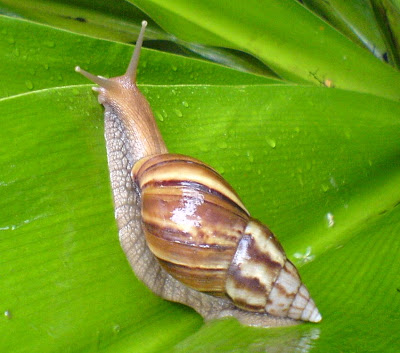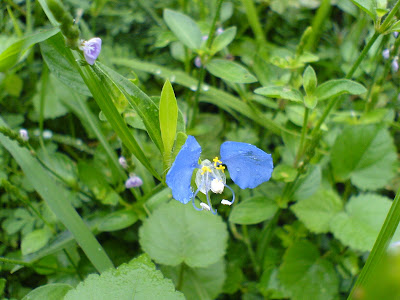Mr Ramanan was at Ayyalur and Srivilliputhur recently and made a determined and successful search for the slender loris and the grizzled squirrel.
The Loris tardigradus malabaricus is a species of loris confined to India and mainly found in the south-eastern Ghats. Loris are nocturnal primates, that are quite small, with slender arms and legs but huge saucer-like eyes!
Mr Ramanan's pictures and account (which follow below), intrigued me to learn some more about this strange creature. The loris is arboreal (lives in trees) and has an insectivrous diet, for the most part. I read about their strange habit of urine washing and their fondness for bad-smelling insects!
They are on the endangered list, threatened by habitat destruction as also poaching. If you want to read more about all the ghastly uses their body parts are hunted for, please read Slender Loris Gasps For Survival As Urban India Expands
The Grizzled Gaint Squirrel - Ratufa macroura - is in the near threatened category. This member of the rodent family is under threat due to being seen as a pest by farmers. Supposedly, these squirrels love fruit, and the farmers are not amused or do not take kindly to the ravaging of jackfruit, mango and tamarind trees!
The Wildlife Trust of India is working among the Srivilliputhur farmers to protect these squirrels and come up with solutions to reduce crop damage. Mr Arumugham, a WTI conservationist, is quoted in this article as saying, “The squirrels do cause losses to the farmers. However, these losses can be reduced by simple understanding of the squirrel behaviour. For example, when a squirrel feeds on a jackfruit, say, it will continue to feed on the same fruit if not removed. Only if the farmers pluck out the damaged fruit, the squirrels move on to a new fruit,”
Here is Mr Ramanan's pictures and report!

"On the 7th of August, 2010 after attending my fathers’ anniversary at Gandhigram, we proceeded to Ayyalur with Mr.Ramdass of Gandhigram who has done a project on medicinal plants of that range. (Ayyaluru is on the way to Trichy from Dindigul on
NH45. It is exactly 30KM from Dindigul.The Forest Range Office is very close to the railway station and that is the entry point for Ayyaluru Range. FromChennai it is about 420KM). Many of our MNS members are familiar with Gandhigram for various activities as well as the first BIRD FAIR which was organized at the Deemed University of Gandhigram.
"We were well received by the Forest Range Office of Ayyalur as both Gandhigram and Forest Department have combined together and done a lot of welfare projects for the villagers living there. From the Range office we proceeded to a place called Ayyanarkoil Palathottam. The Ayyalur range has a lot of hillocks. For sighting of Slender Loris we were advised to trek the Beerangi Karadu hill which is also the foot of Ayyanarkoil. The name of the hill is derived because the British had used this hilltop to attack the Tippu Sultan palace of Dindigul with beerangi[cannons] and the remains of it are still seen at the top of the hill, as was narrated to us by the villagers


"As we trekked, I was at home with the terrain that resembled the open thorny, euphorbia scrub forest of our Nannmangalam forest, but without the quarry with water body. Half way up the hillock with the assistance of a local boy Ganesan at 5.40PM we sighted a wild slender loris on a neem tree. But on seeing us it used the neem leaves as a cover and moved away to an unreachable branch in no time and afterwards it was not sighted again.
After scanning and searching for more than an hour in the hill, the local boy took us to the foot of the hill and nearer to the villagers where bananas, coconut and other crops were seen. Nearer to this place at 6.40 PM, a pair and one with infant were sighted,
And at 7.00PM another boy had located the fourth loris rolled like tennis ball fast asleep! On hearing us she also woke up along with her infant. By this time it had become dark even with torchlight we couldn’t locate any of them till 8.30PM, but we heard a number of calls of them from various directions. So we had seen a total of four with two infants in a radius of a kilometer which is good as far as sighting of wild slender loris goes!

"The next day I proceeded to Srivilliputhur for sighting of "white squirrel" as termed by the locals of that place for grizzled giant squirrel. With the help of local SBI staff Mr. Mani we proceeded to Shenbaga thoppu where Pechiamman Koil is situated. Mr. Mani has very great trekking experiences of that place and even trekked to Mudaliaroothu on many occasions. We MNS under the leadership of our beloved Mr. Rajan, the then secretary also trekked and had a nature camp in those days at Mudaliaroothu. As we have seen this squirrel near a stream while on one of the nature camp of MNS in Chinnar, we tried our luck in a stream behind the temple. On the other side of the stream in huge original shola trees surrounded with wild mango trees we sighted three of them playing in the top branches.
In and around the stream there was a lot of elephant’s dung, so we didn’t venture further inside. While standing underneath a tall tree we were hit on our heads continusly with nuts. On looking up the tree was full of jamun fruits and along with the three striped squirrels, two grizzled squirrels were also feeding on these fruits. And whenever the devotees of the temple came there to collect water the grizzled squirrels froze behind the big branches and disappeared for some time until silence returned to the place. We waited patiently for more than three hours and finally they cooperated with us and literally posed for us to photograph them.
Ayyalur is a really fantastic place not only for slender loris but for other animals also present there.The Sand boa snake which is now smuggled out of our country is from this range only. There are so many more wonders, and I can go on an on!"


"On the 7th of August, 2010 after attending my fathers’ anniversary at Gandhigram, we proceeded to Ayyalur with Mr.Ramdass of Gandhigram who has done a project on medicinal plants of that range. (Ayyaluru is on the way to Trichy from Dindigul on
NH45. It is exactly 30KM from Dindigul.The Forest Range Office is very close to the railway station and that is the entry point for Ayyaluru Range. FromChennai it is about 420KM). Many of our MNS members are familiar with Gandhigram for various activities as well as the first BIRD FAIR which was organized at the Deemed University of Gandhigram.
"We were well received by the Forest Range Office of Ayyalur as both Gandhigram and Forest Department have combined together and done a lot of welfare projects for the villagers living there. From the Range office we proceeded to a place called Ayyanarkoil Palathottam. The Ayyalur range has a lot of hillocks. For sighting of Slender Loris we were advised to trek the Beerangi Karadu hill which is also the foot of Ayyanarkoil. The name of the hill is derived because the British had used this hilltop to attack the Tippu Sultan palace of Dindigul with beerangi[cannons] and the remains of it are still seen at the top of the hill, as was narrated to us by the villagers


"As we trekked, I was at home with the terrain that resembled the open thorny, euphorbia scrub forest of our Nannmangalam forest, but without the quarry with water body. Half way up the hillock with the assistance of a local boy Ganesan at 5.40PM we sighted a wild slender loris on a neem tree. But on seeing us it used the neem leaves as a cover and moved away to an unreachable branch in no time and afterwards it was not sighted again.
After scanning and searching for more than an hour in the hill, the local boy took us to the foot of the hill and nearer to the villagers where bananas, coconut and other crops were seen. Nearer to this place at 6.40 PM, a pair and one with infant were sighted,
And at 7.00PM another boy had located the fourth loris rolled like tennis ball fast asleep! On hearing us she also woke up along with her infant. By this time it had become dark even with torchlight we couldn’t locate any of them till 8.30PM, but we heard a number of calls of them from various directions. So we had seen a total of four with two infants in a radius of a kilometer which is good as far as sighting of wild slender loris goes!

"The next day I proceeded to Srivilliputhur for sighting of "white squirrel" as termed by the locals of that place for grizzled giant squirrel. With the help of local SBI staff Mr. Mani we proceeded to Shenbaga thoppu where Pechiamman Koil is situated. Mr. Mani has very great trekking experiences of that place and even trekked to Mudaliaroothu on many occasions. We MNS under the leadership of our beloved Mr. Rajan, the then secretary also trekked and had a nature camp in those days at Mudaliaroothu. As we have seen this squirrel near a stream while on one of the nature camp of MNS in Chinnar, we tried our luck in a stream behind the temple. On the other side of the stream in huge original shola trees surrounded with wild mango trees we sighted three of them playing in the top branches.
In and around the stream there was a lot of elephant’s dung, so we didn’t venture further inside. While standing underneath a tall tree we were hit on our heads continusly with nuts. On looking up the tree was full of jamun fruits and along with the three striped squirrels, two grizzled squirrels were also feeding on these fruits. And whenever the devotees of the temple came there to collect water the grizzled squirrels froze behind the big branches and disappeared for some time until silence returned to the place. We waited patiently for more than three hours and finally they cooperated with us and literally posed for us to photograph them.
Ayyalur is a really fantastic place not only for slender loris but for other animals also present there.The Sand boa snake which is now smuggled out of our country is from this range only. There are so many more wonders, and I can go on an on!"





 Dunlin - Photo by Skandan
Dunlin - Photo by Skandan Nanmangalam reserve forest - the landmark hill within
Nanmangalam reserve forest - the landmark hill within  The quarry - filled with rain water, but look at the floating thermocol
The quarry - filled with rain water, but look at the floating thermocol Clcik on the pcture, and you will see that the white floating substance at the far end on the water is more thermocol
Clcik on the pcture, and you will see that the white floating substance at the far end on the water is more thermocol The bags of garbage we cleared in one hour...there is much more.
The bags of garbage we cleared in one hour...there is much more. Terminalia arjuna - fruiting
Terminalia arjuna - fruiting Morinda citrifolia-Nuna
Morinda citrifolia-Nuna

 The huge snail that caught all the oohs and aahs
The huge snail that caught all the oohs and aahs Commelina - day flowers
Commelina - day flowers Tree unknown
Tree unknown Plumeria obtusa - Singapore frangipani
Plumeria obtusa - Singapore frangipani